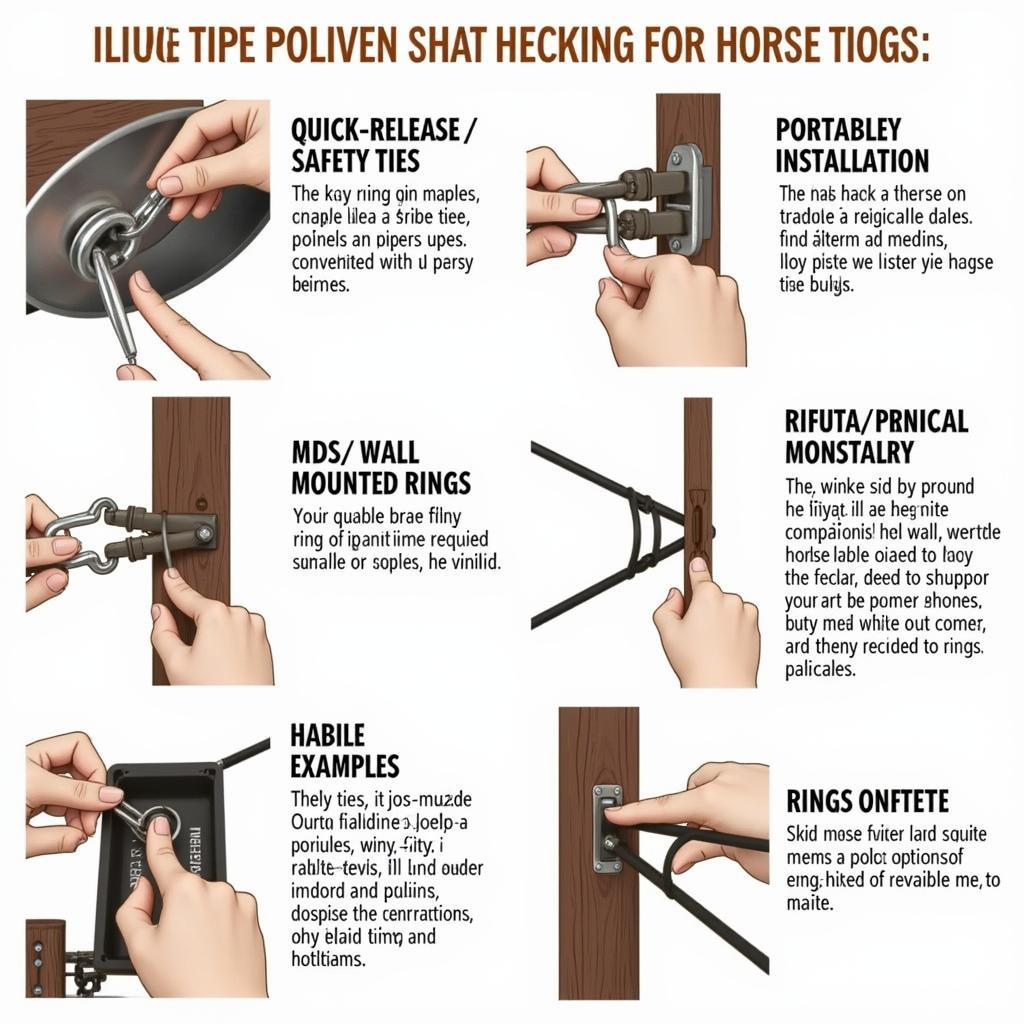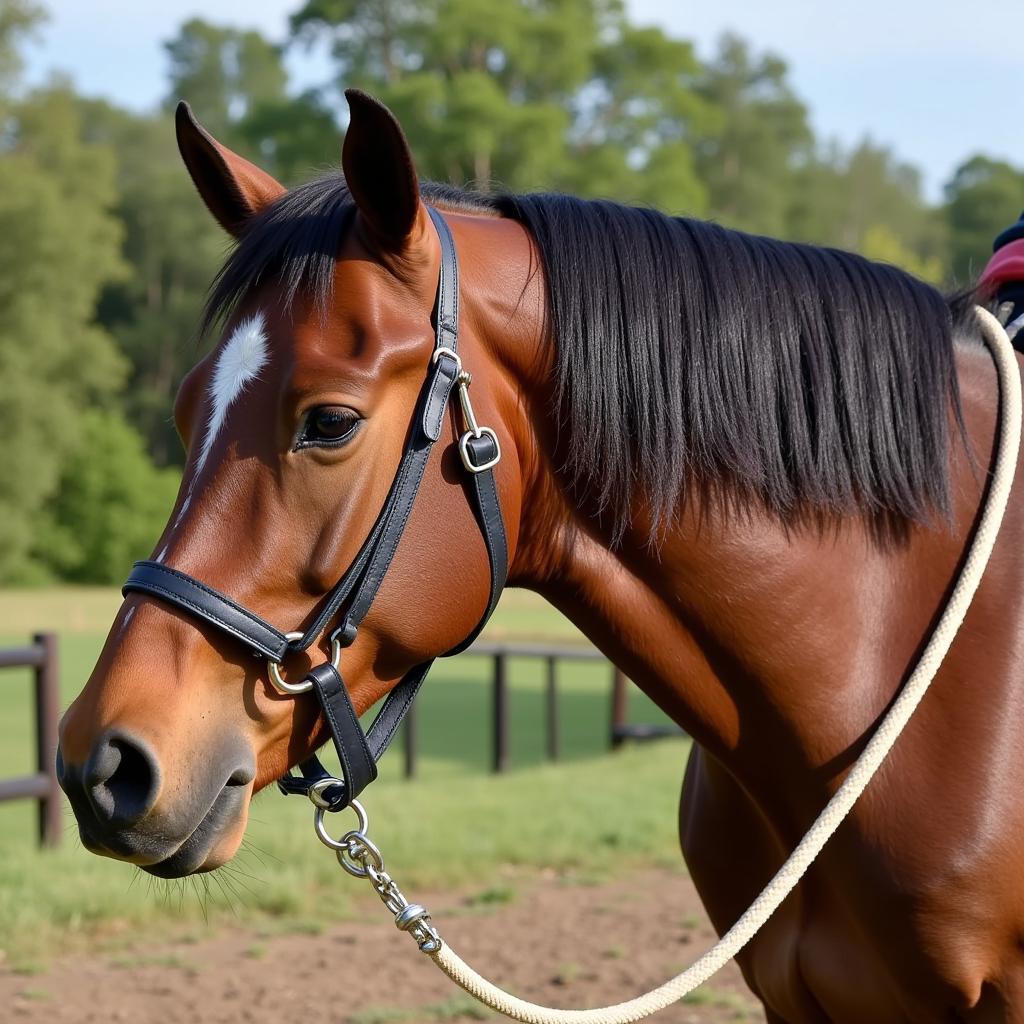A Horse Tie Ring might seem like a simple piece of equipment, but selecting the right one is crucial for your horse’s safety and comfort. This guide will delve into the various types of horse tie rings available, helping you make an informed decision based on your specific needs and circumstances.  Different Types of Horse Tie Rings
Different Types of Horse Tie Rings
Different Types of Horse Tie Rings
There are numerous types of horse tie rings on the market, each designed for a particular purpose. Understanding these differences will help you choose the safest and most appropriate ring for your horse.
Quick-Release Rings
Quick-release rings are designed for safety, allowing you to quickly untie your horse in an emergency. These rings usually have a mechanism that can be easily opened with one hand, preventing your horse from getting tangled and potentially injured.
Safety Ties
Similar to quick-release rings, safety ties offer a quick-release mechanism, but they often incorporate a breakaway feature. This means that the tie will break under a certain amount of pressure, preventing serious injury if the horse pulls back suddenly.
Wall-Mounted Rings
Wall-mounted rings are a popular choice for barns and stables. They offer a secure and permanent tying solution. When choosing a wall-mounted ring, ensure it is made from durable material and installed correctly into a sturdy wall or post.
Portable Rings
Portable rings offer flexibility, allowing you to tie your horse anywhere. These rings typically attach to a fence post or trailer and can be easily moved as needed.
Rings on Posts
Permanent posts with tie rings are a common sight in pastures and paddocks. They provide a convenient place to tie your horse while grooming, saddling, or simply for a short rest.
Materials and Construction
The material and construction of a horse tie ring are just as important as its type. A well-made ring will be strong, durable, and resistant to rust and corrosion.
Steel Rings
Steel rings are a popular choice due to their strength and durability. However, they can rust if not properly coated or maintained.
Stainless Steel Rings
Stainless steel rings offer excellent corrosion resistance, making them ideal for outdoor use. They are also strong and durable, making them a good investment in the long run.
Brass Rings
Brass rings have a classic look and are resistant to rust. However, they are not as strong as steel and can be more expensive.
Choosing the Right Tie Ring for Your Needs
When choosing a horse tie ring, consider the following factors:
- Your horse’s temperament: For horses that tend to pull back, a safety tie or quick-release ring is recommended.
- The location: Wall-mounted rings are suitable for stables, while portable rings are ideal for temporary tying situations. If you’re interested in blocker horse tie rings, check out our dedicated page: blocker horse tie ring.
- Your budget: Steel rings are generally the most affordable, while stainless steel and brass rings are more expensive. If you’re in Hawaii, you might find some unique options: hawaii horses.
- The ring’s size: The ring should be large enough to accommodate the rope or lead rope without pinching the horse.
 Horse Tied Safely to a Ring
Horse Tied Safely to a Ring
Do you have horses for sale? Check out our black Percheron horses: black percheron horses for sale.
Installation and Maintenance
Proper installation and regular maintenance are essential for ensuring the safety and longevity of your horse tie ring.
Installing Wall-Mounted Rings
When installing a wall-mounted ring, it’s crucial to use appropriate hardware and ensure it is securely fastened to a strong support.
Maintaining Your Tie Ring
Regularly inspect your tie rings for signs of wear and tear. Replace any damaged rings immediately. For those interested in horse-related collectibles, see our selection of Jim Beam decanters: jim beam horse decanter.
“A well-maintained tie ring is a safe tie ring,” says Dr. Emily Carter, DVM, an equine veterinarian with over 20 years of experience.
For information regarding recent fire incidents, please visit: hungry horse fires.
“Always choose a tie ring made from durable materials and ensure it’s installed correctly,” adds John Miller, a farrier with over 30 years of experience.
Conclusion
Choosing the right horse tie ring is a critical aspect of horse ownership. By considering your horse’s needs, the intended location, and the ring’s material and construction, you can ensure a safe and comfortable tying experience for your equine companion.
FAQ
- What is the best type of tie ring for a horse that pulls back? A quick-release or safety tie is recommended for horses that tend to pull back.
- How often should I inspect my horse tie rings? You should inspect your tie rings regularly, at least once a month, for signs of wear and tear.
- What material is best for horse tie rings? Stainless steel is a great choice for its durability and resistance to rust.
- How do I install a wall-mounted tie ring? Ensure you use appropriate hardware and secure it to a strong support. Consult a professional if necessary.
- What size tie ring do I need? Choose a ring large enough to accommodate the rope or lead rope without pinching the horse.
- Where can I buy quality horse tie rings? Check with your local tack store or search online retailers specializing in equine equipment.
- Are there any specific regulations regarding horse tie rings? While there aren’t specific regulations about the rings themselves, always prioritize safety and ensure proper installation and usage.
Need assistance? Contact us 24/7 at Phone Number: 0772127271, Email: [email protected] or visit us at QGM2+WX2, Vị Trung, Vị Thuỷ, Hậu Giang, Việt Nam.